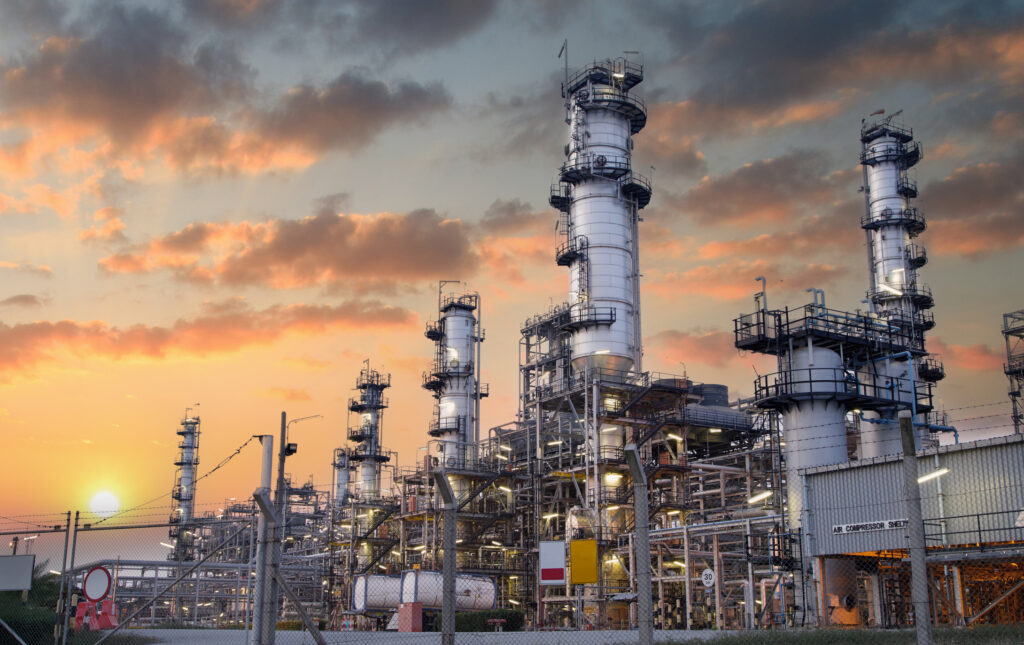The refinery catalyst market is pivotal in the oil and gas industry. These catalysts are fundamental in enhancing the efficiency and sustainability of oil refining processes.
This article offers insights into current trends, challenges, and opportunities that define this dynamic market.
The Role of Catalysts in Oil Refineries

Refinery catalysts are essential in the oil refining process, serving as the unsung heroes that enhance efficiency, ensure environmental compliance, and boost economic performance. Here, we break down their pivotal role into easily digestible points.
Boosting Efficiency
Refinery catalysts are all about optimizing performance. They speed up chemical reactions, ensuring that oil is refined quickly and effectively. This means higher productivity and lower energy consumption, leading to optimal operational efficiency.
Versatility in Action
Oil refining isn’t a one-size-fits-all operation. Different processes need different catalysts. Whether it’s cracking, reforming, or hydrotreating, catalysts ensure each process is tailored for optimal results. It’s about having the right tool for the job, ensuring adaptability and efficiency.
Guardians of the Environment
With the world’s eyes on pollution and emissions, refinery catalysts step up as environmental protectors. They help reduce harmful emissions and pollutants, ensuring refineries meet strict environmental standards and contribute to a cleaner, greener planet.
Cutting Costs, Adding Value
Economically, refinery catalysts are game changers. By making processes more efficient and reducing waste, they cut operational costs. They also enhance the quality of the final petroleum products, adding value and making them competitive in the market.
Looking Ahead
In the fast-paced world of technology, refinery catalysts aren’t being left behind. They’re becoming smarter and more responsive, integrating with technologies like AI and IoT. This means better performance, real-time monitoring, and predictive maintenance, leading to a future where refineries are as intelligent as they are efficient.
Current Trends in the Oil Refinery Catalyst Market

Innovations and trends in the refinery catalyst market reflect the rapid evolution and complexities of the oil and gas sector.
These trends are not just shaping the present but are laying the foundation for a future where efficiency, sustainability, and innovation coalesce, driving the oil and gas sector towards an era of enhanced productivity and environmental stewardship.
Technological Innovation
The market is witnessing an influx of advanced materials and methodologies designed to enhance the efficiency and efficacy of refinery catalysts.
Emerging technologies are augmenting traditional catalysts, introducing a spectrum of enhanced features, including increased durability, higher activity, and improved selectivity.
Eco-Friendly Catalysts
The demand for green, eco-friendly catalysts is escalating as the world gravitates towards sustainable practices. The refinery catalyst market is responding with the development of catalysts that optimize refinery operations and minimize environmental impact.
These catalysts are engineered to reduce greenhouse gas emissions, conserve energy, and promote the utilization of renewable resources.

Customization & Specialization
Customization is another prominent trend. Refinery catalyst suppliers are offering tailored solutions to meet the specific needs of varied operations.
Every refinery has its unique challenges, and customized catalysts ensure that specific operational, regulatory, and environmental requirements are met with precision.
AI & ML Integration
These technologies are being employed to optimize catalyst performance, predict maintenance needs, and enhance operational efficiency. The infusion of AI and ML is expected to revolutionize catalyst management and application, bringing in an era of predictive and prescriptive maintenance and operation.
Regulatory Compliance
New formulations and technologies ensure that catalysts enhance operational efficiency and comply with global and regional regulatory standards, balancing performance with ecological preservation.
Collaborative Partnerships
Strategic collaborations and partnerships are becoming common, fostering innovation and technology transfer. Refinery catalyst suppliers are collaborating with tech companies, research institutions, and refineries to develop next-generation catalysts that combine operational excellence with sustainability.
Global Expansion
The globalization of the market is another notable trend. Suppliers and manufacturers are expanding their footprint globally, tapping into emerging markets. Technological advancements, strategic alliances, and the evolving needs of the global oil and gas sector facilitate this expansion.
Challenges Facing the Refinery Catalyst Market

The refinery catalyst market is navigating through a dynamic and complex landscape, shaped by various challenges that affect not only the suppliers but extend their impact to customers and the industry at large.
These challenges influence decision-making processes, operational efficiency, and strategic planning for businesses operating within this ecosystem.
Fluctuating Oil Prices
Volatility in oil prices directly affects the entire oil and gas sector, including the refinery catalyst market. For customers, fluctuating oil prices can lead to uncertainty in operational costs and investment planning. It necessitates adaptive strategies to maintain profitability and efficiency amidst variable economic conditions.
Environmental Regulations
Stringent environmental regulations impact the design, operation, and maintenance of refineries. Buyers must seek catalysts that enhance operational efficiency and comply with the ever-evolving environmental standards. This has increased demand for innovative, eco-friendly catalyst solutions that align with global sustainability goals.
Supply Chain Vulnerabilities
Supply chain disruptions can have a cascading effect on the refinery catalyst market and its clientele. The availability, timely delivery, and cost of catalysts are subject to the robustness of the global supply chain. End-users, particularly, have to develop contingency plans to mitigate the impact of potential supply chain disruptions on their operations.
Customization Needs
The move towards customized solutions is a double-edged sword. While it allows for tailored solutions that cater to specific operational needs, it also poses challenges related to cost, availability, and scalability.
Refineries and other customers are tasked with aligning their specific operational requirements with available customized catalyst solutions in the market, ensuring compatibility and cost-effectiveness.
Resource Optimization
For end-users, optimizing the use of catalysts to achieve maximum operational efficiency while minimizing costs and environmental impact is a prevailing challenge. It involves continuous monitoring, maintenance, and upgrading of catalyst systems to align with industry best practices and regulatory requirements.
Opportunities in the Global Refinery Catalyst Market

Refinery catalyst market opportunities are emerging as robust pathways for growth, innovation, and sustainable development.
These opportunities are not isolated; they are integrative and multidimensional, bridging gaps and addressing challenges to pave the way for a prosperous future.
Scale Sustainably
There is a burgeoning demand for sustainable and environmentally friendly catalyst solutions. This surge is driven by regulatory requirements but is also a reflection of the industry’s commitment to global sustainability goals.
Applied Catalysts is at the forefront of this transition, offering eco-efficient catalysts that align operational efficiency with environmental preservation.
Customized Solutions
With the diverse and complex needs of refineries, customized catalyst solutions have emerged as a significant opportunity. Applied Catalysts stands out as a partner that understands the unique operational, regulatory, and environmental challenges of each client.
We offer tailored catalyst solutions designed to optimize performance, efficiency, and compliance.
Expanding Markets
The global refinery catalyst market is expanding into new geographies and sectors. This expansion is characterized by a diversification of needs and opportunities.
Applied Catalysts, with its global reach and versatile product portfolio, is well-positioned to cater to this diversifying clientele, offering solutions that are globally applicable yet locally relevant.
Research and Development
Innovation is the lifeblood of opportunities in the catalyst market. Applied Catalysts invests heavily in R&D, ensuring our clients access to the latest, most efficient, and compliant catalyst solutions.
Our innovations address current challenges and anticipate future trends, positioning our clients at the cutting edge of industry advancements.
Strategic Partnerships
Collaborations and partnerships are pathways to synergistic growth.
By partnering with Applied Catalysts, clients gain a supplier and a strategic ally committed to mutual growth, innovation, and sustainability.
Our collaborations are marked by shared insights, joint innovations, and a commitment to pushing the boundaries of what’s possible in the refinery catalyst market.
Elevate Refinery Performance With Applied Catalysts

Ready to increase efficiency, meet environmental standards, and boost your bottom line? Applied Catalysts provides straightforward solutions tailored to your specific needs.
Explore our range of effective and customizable refinery catalysts. It’s not about a one-size-fits-all approach but delivering precisely what your operation needs to excel.
Contact us to find the tailored catalyst solution that fits your refinery’s requirements. No fluff, just results.
Recent Posts
MicroFlo Reactors for the Nitration of Aromatic Substrates
Explore advancements in nitration reactions using MicroFlo reactor technology. Learn how it enhances safety, efficiency, and production rates compared to traditional batch methods.
Read MoreManufacturing Compliance: Monitor and Reduce VOC Emissions Effectively
As companies strive to meet environmental standards, VOC (Volatile Organic Compounds) abatement is a critical focus area, particularly for the manufacturing industry. Staying compliant with local and national regulations is…
Read MoreUnderstanding Catalyst Deactivation: How Characterization Can Identify the Root Cause
AbstractCatalyst deactivation is a common challenge in many catalytic processes, but by identifying the root causes, taking appropriate corrective actions, and utilizing advanced characterization techniques, it is possible to maintain…
Read More


